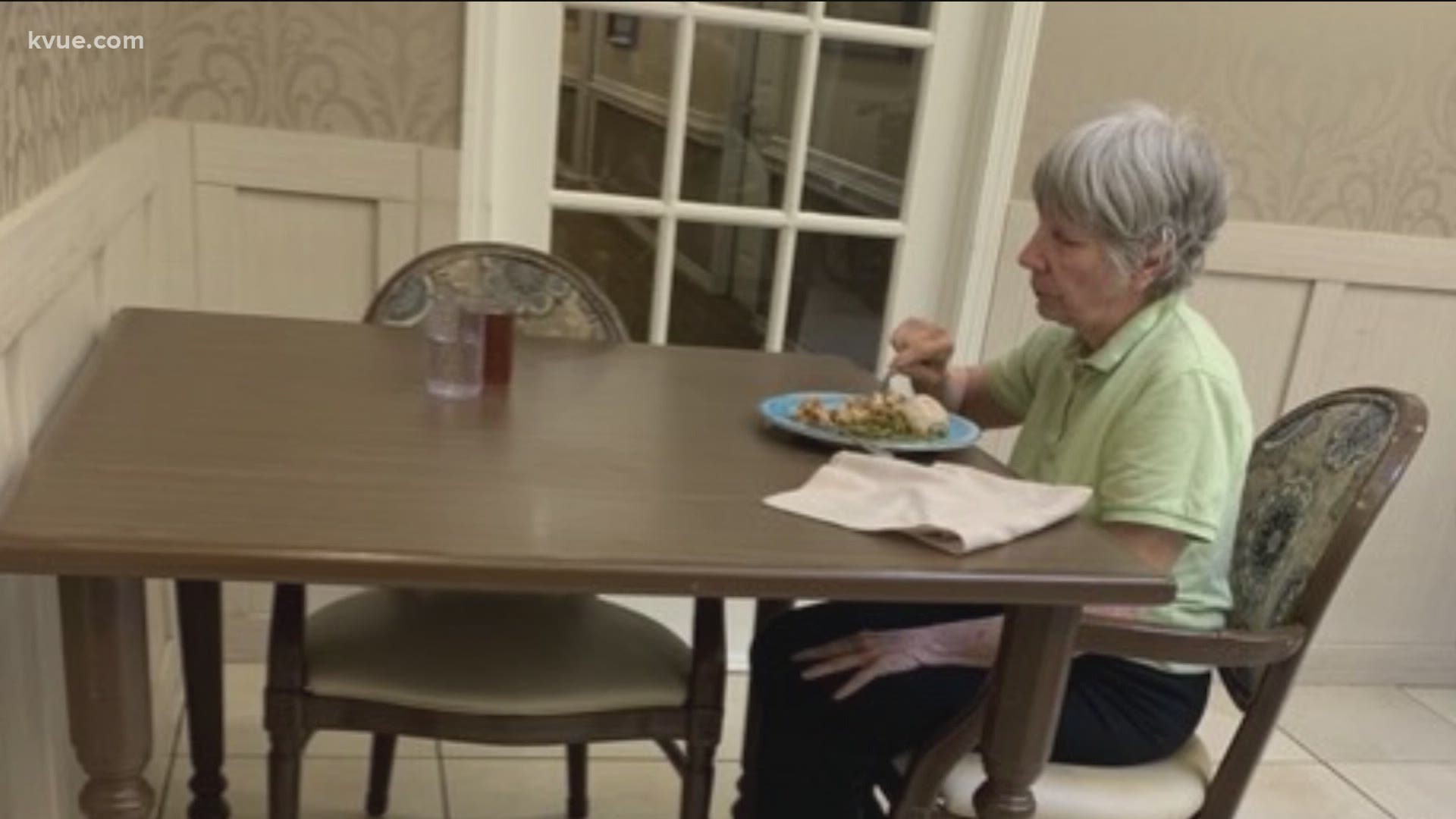AUSTIN, Texas — COVID-19 has hit nursing homes and assisted living centers hard, but some families say the isolation is just as bad.
In a world without words, pictures speak volumes. Ask the hundreds of families posting pictures of their loved ones on the Texas Caregivers for Compromise Facebook page and you can't help but feel the heartbreak.
Stefanie Taylor is living it.
“Over the last two months, she [my mother] went from being just in a wheelchair, being able to carry on a conversation, being able to express herself, to literally now she is lying in a bed. She sleeps most of the time. She hardly can speak. And now I have to feed her,” said Taylor.
COVID-19 has been especially cruel to seniors in nursing homes. Our state is averaging 117 cases per 1,000 residents and 17 deaths per 1,000 residents. But families say it's not just COVID-19 killing seniors.

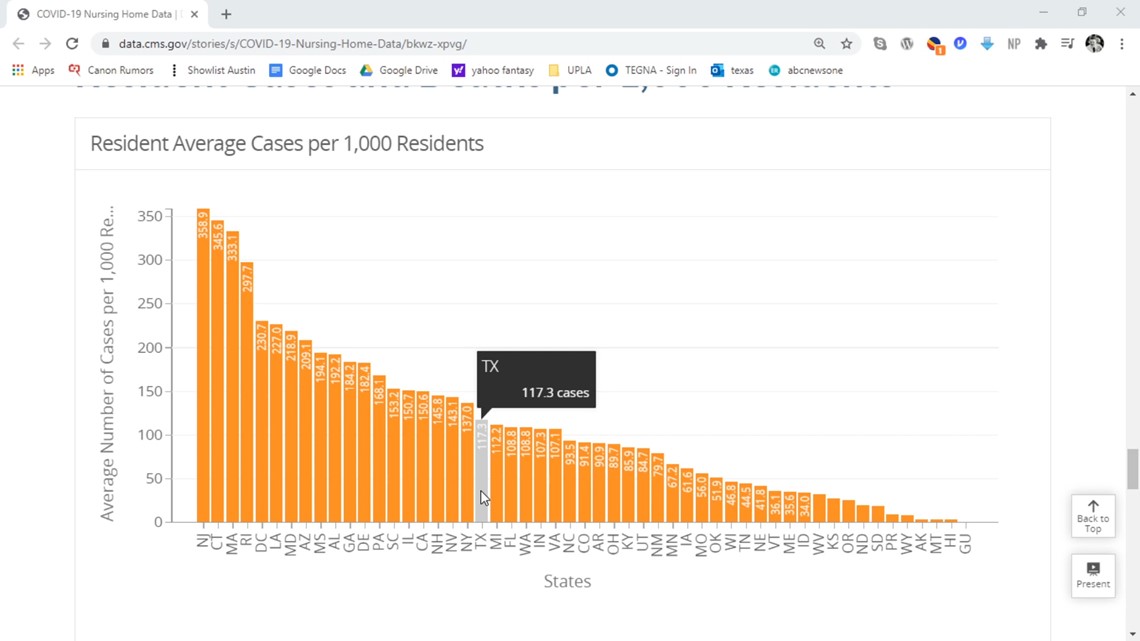

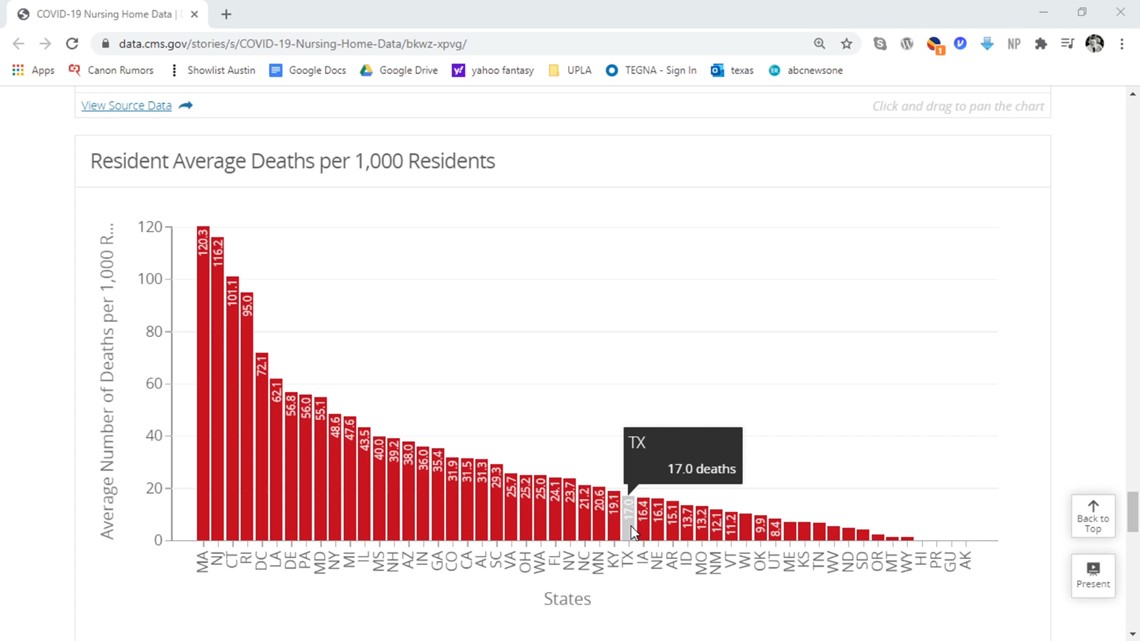
"I don't know many more cruel things than just leaving them locked away, either in their rooms or just completely confined to that one facility for six months. It's not right. It's not right," said Glenna Butler, an only child who visited her mom regularly before COVID-19. Her visits are now through a window.
'Your cure can't be worse than the illness'
“Your cure can't be worse than the illness. These are human beings and they deserve to have a say in what happens to this latter part of their lifetime,” said Butler.
Families across the state are sharing their stories in hopes that someone will listen, heartbreaking stories like Monica's.

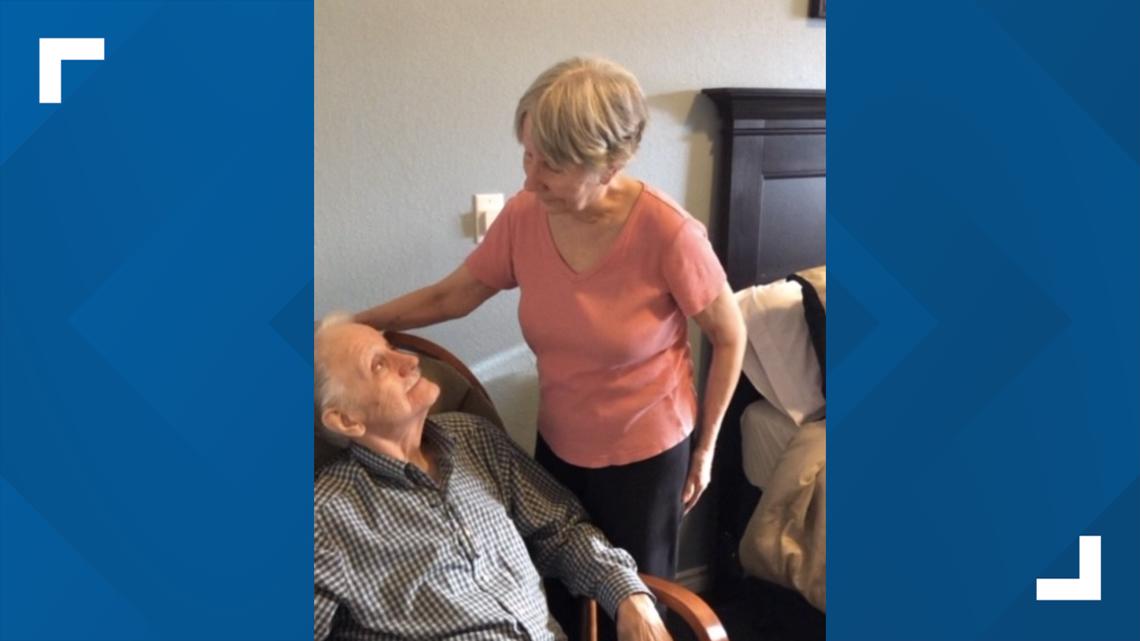

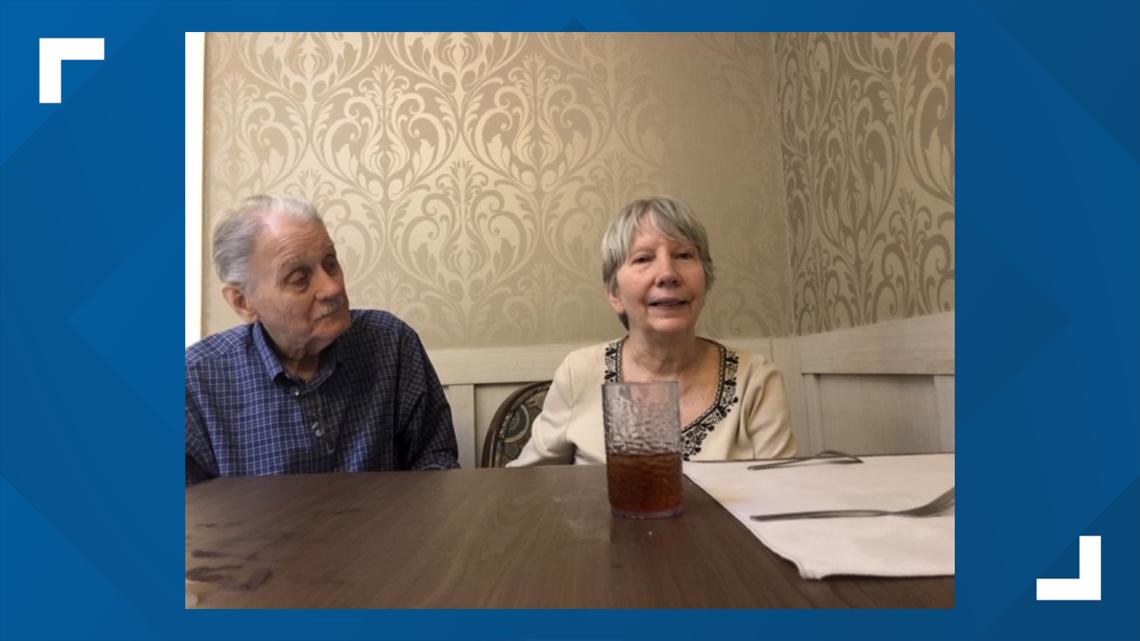
Her dad, Lynn Howell, is a Vietnam War veteran with three purple hearts who is currently battling leukemia caused by repeated exposure to Agent Orange. Her mom, the love of his life, is in a nursing home with dementia. He visited every day before the COVID-19 pandemic. Now he is not allowed in.
The nursing home offered to let him live with her, but he’s afraid he will run out of money and leave his wife with little to nothing if anything happens to him. Both have declined considerably. Both are lonely, feeling abandoned, and they just want a chance to hold hands.


Good intentions with unforeseen consequences
“I know the intentions initially were, of course, good. Everything's based on good intentions, everything that's in terms of isolation. But it's gotten to a point where it's just not, you know, it's just not good. I think we're causing a lot of physiological harm actually at this point to people like my mom who are in the long-term care facilities,” said Tricia Lange.
Research shows loneliness can make people more susceptible to illness. Many families like Taylor’s are learning that firsthand.
Sheryl Madera is a nurse at a long-term care center in Texas.
“You cannot believe the despair and loneliness these residents are dealing with,” she said. “Many do not grasp the concept of what's going on. They see this as their families have dumped and left them at the nursing home and forgot about them. They are not able to comprehend and participate in window or iPad FaceTime videos. Attempts at this cause such anxiety and confusion. To see a resident clawing at the window trying to get to their loved one is gut-wrenching. To see family on the outside crowded around a window to watch a loved one pass away should not be happening, but it is daily. No, they're not dying from COVID; they're dying from a broken heart due to loneliness and isolation. There is no reason that nursing homes should not be open with restrictions. This has got to stop. There needs to be some compassion.”
The home where her mom was staying shut off window visits two weeks ago. Shortly after her mom was diagnosed with COVID-19 and ended up in the hospital.
“At that point, I decided I was going to bring her home on hospice because I knew, I can tell just by looking at her that I didn't have much time with her,” said Taylor.
Visitation policy changes
Just last week, the Texas Department of Health and Human Services extended the no-visitation rules for nursing homes and assisted living centers through Sept. 29. Then, on Aug. 6, the state decided to allow limited visits. However, those must be behind plexiglass whether they are inside or outside and only at facilities with no COVID-19 cases.
"I understand that these people are older, they are more vulnerable, but they are our loved ones, so their safety is number one with us," she said.
It is a crisis within a crisis, with families fighting for more time.

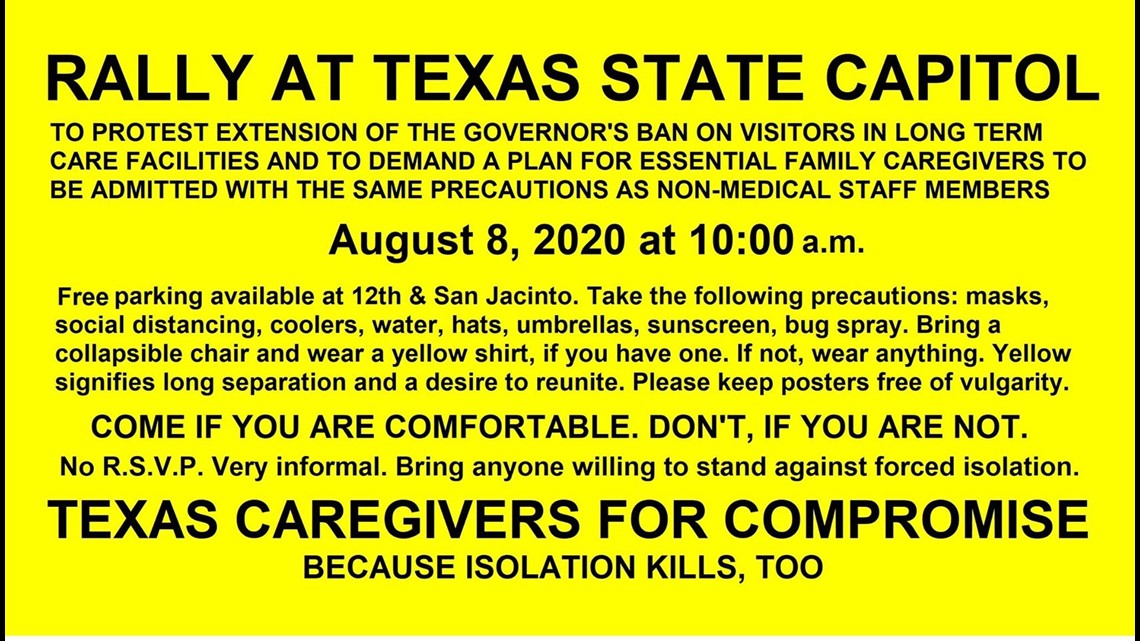
Before the news broke on Aug. 6, families planned to rally outside the Texas Capitol for their parents, their spouses, their children. They want the state to let them visit with their loved ones inside nursing homes, assisted living centers and state health facilities, something they have been denied since March.
This group of families is now circulating a petition for change. They are asking that they be given the same tests as workers in these facilities, wear the same protective gear, but be allowed to have in-person visits with their loved ones. They’ve collected more than 11,000 of the 15,000 signatures they need so far.
Nursing facilities
For the health and safety of facility residents and staff, public visitation is limited to outdoor visits only. Physical contact between residents and visitors is not permitted. Additional conditions a facility must meet to conduct limited outdoor visitation include:
- No confirmed positive COVID-19 cases in staff in the last 14 days.
- No active positive cases in residents.
- Any facility previously experiencing an outbreak that has fully recovered must be adequately staffed and following adequate infection control procedures.
- Facility staff are being tested for COVID-19 weekly.
Further guidance on limited nursing facility visitation rules, which include window visits and vehicle parades, will be posted on the HHSC COVID-19 provider web page.
Long-term care facilities (except nursing facilities)
Limited indoor and outdoor visitation procedures are allowed. Physical contact between residents and visitors is not permitted. Additional conditions a facility must meet to conduct limited visitation include:
- No confirmed COVID-19 positive staff in last 14 days.
- No active positive cases in residents.
- Adequate staffing to facilitate visitation in compliance with infection control requirements.
- Use of plexiglass as a safety barrier for indoor visitation to prevent spread of COVID-19.
Further guidance on limited indoor and outdoor visitation rules will be posted on the HHSC COVID-19 provider web page.
Emergency rule enhancements
Enhanced emergency rules for nursing facilities include:
- Each facility must have a COVID-19 response plan that includes designated staff to work with cohorts of residents who have tested positive for COVID-19, and staff should not change designation from one day to another, unless required to maintain adequate staffing for a cohort.
- All nursing facilities must screen all residents, staff, and people who come to the facility in accordance with specified criteria, and each resident must be screened at least three times a day for signs or symptoms of COVID-19.
- Each facility must have plans for obtaining and maintaining a two-week supply of personal protective equipment and resident recovery plans for continuing care when a resident recovers from COVID-19.
The latest guidance for nursing facilities can be found here.
Texas HHSC continues to investigate all long-term care facilities in the state that report one or more positive case of COVID-19, as well as coordinate closely with local, state and federal health authorities.
For more information about how HHSC is helping Texans affected by COVID-19, visit the HHSC go here.

